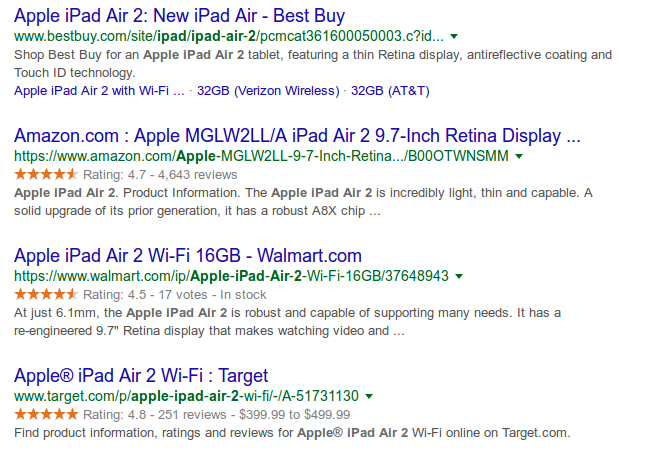Shopify Rich Snippets: Improved organic traffic that converts, without chasing rankings
Every Shopify store wants more revenue and profit. For many stores that means more traffic at the top of their funnel.
Organic search engine traffic is great because it’s free but the time required to build it up can be pretty intense. Since every one of your competitors is fighting for the same traffic and rankings, it’s a zero-sum game. In order for you to win more traffic, your competitor has to lose.
This quickly veers into the huge landscape of SEO. Where PageRank, backlinks, and complicated schemes are the norm.
More traffic, same rankings
For ecommerce stores, there’s a better way though. A way to get more traffic with the search engine rankings you already have.
One that works in tandem with anything else you do for SEO.
It’s also a one-time activity that you set up once and then only takes minimal upkeep.
Sounds like some SEO secret that you’d need to buy some info product to get right?
Nope, none of that here. It’s actually a Google thing and something they want you to use.
Rich Snippets
I’m talking about Google’s Rich Snippets program.
These are a set of enhancements that Google adds to your store’s search results to show additional data about each page.
You’ve actually already seen them before but you might not have realized that’s what they were called.
For Shopify stores, the primary goal is to get Product Rich Snippets so your product data appear directly in the search results. A secondary goal is to get article Rich Snippets for your blog articles and pages.
Rich Snippet examples

Here’s an example of a search result for an iPad Air. I love this one because it shows so many different versions of the Rich Snippets.
The first one from Best Buy has a normal listing but with a few additional links to the different variants of the iPads.
The second one from Amazon shows the rating and reviews Rich Snippet. Notice how eye-catching those orange rating stars are. You can also see there are 4,643 reviews for it on Amazon which means it’s a popular place to buy an iPad.
Walmart in the third spot also has the rating and reviews Rich Snippet though with a lot less reviews. Here you can also see the availability snippet showing that an iPad is in stock. The availability snippet is great for in-demand products that go in and out of stock rapidly.
Finally, the fourth listing for Target shows one of the best snippets: price. Not just one price either, they have the full price range.
Think about your customers buying habits and what they might do with these results.
Knowing my own, if I saw these search results I’d be tempted by the Amazon option above all of the others. If Target shows a lower than retail price, I’d be tempted by it too.
Poor Best Buy. Even though they had the #1 ranking, when comparing them to these competitors their listing looks pretty sad.
Now for another example.

Compare the top result with the rest. Notice how weaker it looks and how easy it is to skip over.
The interesting thing here is how strong REI’s listing is. Even though it’s ranked #4, I’d be willing to bet that it’s pulling more qualified traffic than any of the others.
REI has the review snippet, though not as many reviews as the others.
Their price is 36% less which means it’s easy to compare them against the full retail price.
Also notice how Google is listing extra product information from REI right in the listing.
Finally, look at the amount of space used by the 1st and 4th results. Even though it’s ranked 4th, it’s taking up almost twice the amount of visual space in the search results. That makes it a more noticeable target for a shopper. It’s also pushing any competitors underneath further down the screen.
This goes to show, with the right Rich Snippets your store can beat out the manufacturer on their own product.
Benefits of Rich Snippets
I covered a lot of the benefits in the deconstruction of the examples above but I’d like to spell out the two important ones here.
1. More visual weight
First off, you get more visual weight to your search listings. Comparing a regular listing to one with all of the extra data means that you could double the size of your product’s page in the search results.
Especially if you are able to get product reviews into the listing. Those orange stars really stand out on Google’s blue/white pages.
2. Better quality traffic that converts
Second, with Rich Snippets you’re going to get better quality traffic. Instead of fly-by window shoppers, you’re going to get more wallet-out “just show me your add to cart button please” customers.
As you can see in the examples, someone is able to check the stock, price compare, and do a basic store evaluation all from the search results.
That means your traffic is coming primed to buy which will drive up your conversion rate.
The process to get Rich Snippets
Getting Rich Snippets is a pretty simple process but it does require learning new things and a lot of patience. Google is known to take its time adding them so it’s a “hurry up and wait” situation.
- Add structured data to your store to describe what’s on each page.
- Google will recognize the structured data during its crawls.
- Google will analyze the data and if they like what they see, add Rich Snippets to your store.
Primer on Structured Data
The first thing you need to do, and really the only thing you have to do, is to add structured data to your store.
Structured Data is a term that encompasses a huge body of information so it’s easy to go off into the deep end with it. I’m going to describe the minimum you need to know in order to get started, focusing on what Google needs.
Structured data format
The format of the structured data is how it’s assembled. There are three main formats of structured data:
- Microdata
- JSON-LD
- RDFa
They all can work but really I see microdata and JSON-LD used the most with Shopify stores. Google recommends using JSON-LD and I found it’s vastly easier to work with than microdata.
Data vocabulary
Then there are a few different vocabularies you can use. To simplify things, just use the Schema.org vocabulary.
There are older ones out in the wild but I’ve noticed Google dropping support for them in favor of Schema.org.
Data Types
Finally, there are the types of data your store needs. These describe what things are on your site and for ecommerce sites there are five that you want to have:
- Product to describe your products.
- Offer to describe how you’re selling or offering your products (e.g. price, options).
- AggregateRating to summarize a product’s rating and reviews.
- Organization to describe your business.
- WebSite to describe how to search your store. If you’re lucky Google will add your store’s search field to the results themselves.
My recommendations
Put all that together and you want to use:
- JSON-LD
- using Schema.org
- with those five sets of data
Existing structured data
Your store might have some structured data in place already. For example, all Shopify themes offered in the Shopify store are required to have some structured data.
Unfortunately, most of the time the structured data that comes with Shopify themes or any design are lacking.
The problem is that structured data isn’t very well known among web developers and designers. I’ve worked on websites professionally for over ten years before I actually learned about how to use structured data properly.
If your store is lucky and you already have structured data, it makes the most sense to build on that. Even if it isn’t using the JSON-LD format I recommend.
Testing your store’s structured data
Luckily Google has created a great tool to test any webpage’s structured data, called the Google Structured Data Testing Tool.
Using this you can put in different URLs for your store and see a list of the structured data that Google finds.

You’ll want to test a few pages: your homepage and a couple of product pages.
You can also test competitor pages which can be especially useful to figure out how they got their own Rich Snippets.
In an ideal case you’ll find all of the structured data I described above on a product page:
- Product
- Offer
- AggregateRating
- Organization
- Website
Your homepage might not include the Product, Offer, or AggregateRating but that’s okay. Those sets of data are supposed to describe a specific product and most of the time home pages are so scattered that there isn’t a good single product to describe.
You also must make sure there are no errors or warnings shown. An error can block Google from showing any of that data in the search listing. So if you had an error on your Product data, you won’t get any of that product data into the Rich Snippets.
Warnings are lesser-grade Errors. They won’t prevent you from getting Rich Snippets but I’ve found that customers with warnings tend to have inconsistent results in Google. The most common warning I see on Shopify stores is an incorrectly formatted product price. I’d bet your store has that.
You also might see multiple sets of the same structured data. It’s 100% okay.
Search engines will review all of the sets and can usually pick which one they’ll use. Sometimes it’s done based on their format preference (JSON-LD vs microdata), other times it’s based on showing the most complete set of data.
Setting up structured data: DIY approach
If your store doesn’t have any structured data or something is wrong with it, you have a few options.
You could go the DIY route and update your store’s structured data yourself, filling in the missing pieces, and correcting errors.
It’s not terribly difficult. Anyone with a moderate level of web development experience should be able to do it after some research into structured data and Google’s documentation.
I usually say 3-4 hours of research is enough to learn about structured data and be able to add it to a store.
Depending on your store theme, the actual time needed to perform the updates can vary wildly. My experience is with Shopify where a couple of hours is enough to update the entire store.
So you’re looking at 5-6 hours or so of work to add them yourself, assuming you’re at a moderate level of experience in development.
Depending on your situation, this might not be the best use of your time though.
Setting up structured data: Hire a general web developer
Alternatively, you could hire a general web developer to do the updates for you. Same basic idea as the DIY version just you wouldn’t have to edit things yourself.
This is a great option if you have someone on staff or an agency on retainer.
Setting up structured data: Apps and services
Structured data is interesting. Unlike visual design, it’s very structured (pun intended). This means companies are able to standardize the process and make it really easy to systematize and automate.
Remember how the DIY method required a few hours to learn about structured data and how it works?
Well with these apps and services, you can take advantage of the company or software already doing that research and just knowing what to do. Then it’s just a process of implementation.
I’ve seen consultants who specialize in structured data as well as apps like my JSON-LD for SEO that go a step further and completely automate it. Assuming they follow the specifications and recommendations, their result is as good if not better than a manually done or DIY version.
Where you need structured data
You’ll want to put structured data on every page of your store that you want Google to enhance with Rich Snippets.
That means if you’re on multiple platforms, you’ll want them on each platform.
Some like Amazon already come with structured data and you may not be able to modify all of them. You still should use Google’s tool to test a few pages so you’re aware of what’s listed.
Ongoing maintenance
The final thing to do after you have your structured data set up on your store is to schedule a time to regularly review it.
Like I mentioned above, many web designers and developers don’t know about structured data. There’s a strong chance of it becoming incorrect or breaking during site changes if everyone isn’t careful. Redesigns are especially dangerous for this reason. Even installing unrelated apps might change your theme enough to mess up the structured data.
Google can be pretty quick about removing your Rich Snippets when your structured data breaks. One customer lost her Rich Snippets in a week after a redesign. Luckily she caught it and was able to fix them and recover.
One useful tool is Google’s Search Console. It has a Structured Data report that will show you what Google’s detected on your store as well as a graph of it over time. I’ve found it buggy and inconsistent many times but it can give you a bit of help now and then.
Summary
This guide has been a walk-through of how you can start to get more organic search traffic by using Google’s Rich Snippets and structured data.
It’s an easy process to go through and could increase the quantity and quality of your search traffic with a bit of upfront work.
JSON-LD for SEO
Get more organic search traffic from Google without having to fight for better rankings by utilizing search enhancements called Rich Results.
Linking Llama
Link discontinued products to their best substitute. Keep discontinued products published on your website and continue to benefit from traffic to these pages.




